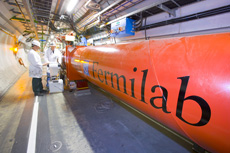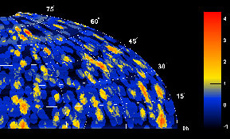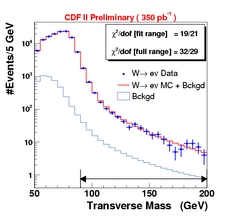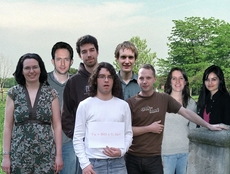|
Thurs., March 29
1:00 p.m.
ALCPG ILC Physics and Detector Seminar - West Wing WH-10NW
Speaker: G. Mavromanolakis, Fermilab
Title: Calice Testbeam Program
1:30 p.m.
Presentations to the Physics Advisory Committee - Curia II
Agenda
THERE WILL BE NO THEORETICAL PHYSICS SEMINAR THIS WEEK
3:30 p.m.
DIRECTOR'S COFFEE BREAK - 2nd Flr X-Over
THERE WILL BE NO ACCELERATOR PHYSICS AND TECHNOLOGY SEMINAR TODAY
6:00 p.m.
UTeV Seminar - 1 West
Speaker: G. Gollin, University of Illinois
Title: The International Linear Collider: A Detector
Physicist Describes Accelerator Physics to
Anyone Who Will Listen
Fri., March 30
8:30 a.m.
Presentations to the Physics Advisory Committee - Curia II
Agenda
3:30 p.m.
DIRECTOR'S COFFEE BREAK - 2nd Flr X-Over
4:00 p.m.
Joint Experimental-Theoretical Physics Seminar - 1 West
Speaker: K. Terashi, Rockefeller University
Title: Diffraction and Exclusive Production at CDF:
Towards Exclusive Higgs at LHC ~
Click here for NALCAL,
a weekly calendar with links to additional information. |
Thursday, March 29
-Santa Fe black bean soup
-Sloppy Joe
-Stuffed peppers
-Sauteed liver and onions
-Baked ham and swiss on a ciabatta roll
-Assorted slice pizza
-Crispy fried chicken ranch salad
Wilson Hall Cafe Menu |
|
Thursday, March 29
Dinner
-Clam chowder
-Filet mignon
-Vegetable of season
-Potato dauphinois
-Chocolate soufflé w/frangelico cream anglais
Wednesday, April 4
Lunch
-Ropa viejas (flank steak shredded)
-Sweet plantain mash
-Coconut cake w/lime filling
Chez Leon Menu
Call x4598 to make your reservation. |
|
|
Fermilab statement on
magnet test failure

An inner-triplet quadrupole during installation in June 2006.
On Tuesday, March 27, there was a serious failure in a high-pressure test at CERN of a Fermilab-built "inner-triplet" series of three quadrupole magnets in the tunnel of the Large Hadron Collider. The magnets focus the particle beams prior to collision at each of four interaction points around the accelerator.
Safety precautions were followed during the test, and no one was injured.
A full investigation of the failure is underway, but preliminary indications are that structures supporting the inner "cold mass" of one of the three magnets within its enclosing cryostat broke at a pressure of 20 atmospheres, in response to asymmetric forces applied during the test. Such forces are expected on occasion during normal operation of the LHC. The failure does not concern the magnets or the cold masses themselves, but rather their assembly in the cryostat.
While the full cause of the problem is not yet known, failure to account for the asymmetric loads in the engineering design of the magnet appears to be a likely cause. The test configuration corresponds to conditions that occur during a magnet quench, when a superconducting magnet suddenly "goes normal," releasing large amounts of energy. They may also occur during magnet cooldown and during certain other conditions such as refrigerator failure. From 1998 to 2002, Fermilab conducted four engineering reviews of the magnets by experts from Fermilab, other US national laboratories and CERN. The reviews do not appear to have addressed these asymmetric loads. Tests at Fermilab were done on single magnets where such loads do not develop.
At this point the consequences, if any, for the LHC schedule are not yet known.
Read more
|
Captured in Ice

Sky map from the AMANDA neutrino telescope showing the 1,112 atmospheric neutrino candidates observed. Scale reflects excess or deficit from mean background events. Image courtesy of Andrea Silvestri, AMANDA, UCI
As scientists explore the most violent phenomena in the universe, the tiny, almost massless particles called neutrinos are valuable messengers, traveling unimpeded across the vast distances of space.
"By analyzing neutrino data on the TeraGrid we've been able to validate a new kind of 'telescope' that gives a dramatic new view of the universe through the window of high-energy neutrinos," says University of California at Irvine astrophysicist Andrea Silvestri. "This can help scientists unravel a number of longstanding mysteries about the origin and apparent surplus of the highest-energy cosmic rays."
Read More
|
|
Wednesday's story on the attempted theft of scrap metal incorrectly
described the container involved as a dumpster, instead of as a recycling
area. Fermilab Today regrets the error.
|
The Arizona Republic
March 28, 2007:
Giant telescope a point of pride
Device a big step for science in Mexico, world
SIERRA NEGRA, Mexico - It looms over Mexico from a mountain so high it's hard to breathe, a massive white radio telescope of monumental proportions.
Its dish is half the width of a football field, stands as high as a 20-story building and watches the sky from a mountain taller than any peak in the contiguous United States.
The Large Millimeter Telescope is the most ambitious scientific project Mexico has ever undertaken, the government says. It also is part of a growing trend, as U.S. and European astronomers search the world for higher, drier sites where they can collect more of the faint signals from space.
Read More |
|
|
The weak force:
How fast does it decay?

The transverse mass distribution for W's decaying to electrons and neutrinos. The size and shape of the tail at large masses, indicated by the horizontal arrow, contains information on the W width. Muon decays are also included in this result.
Heisenberg's uncertainty principle famously states that we cannot measure times and energies simultaneously. A direct consequence of this principle is that the faster a particle decays, the less well defined is its mass. By measuring the range of masses -- the "width" -- occupied by a particle, we can therefore directly infer its lifetime.
W bosons, carriers of the weak nuclear force responsible for certain kinds of radioactive decay, are copiously produced at the Tevatron. They decay with an unimaginably short lifetime of 10-25 seconds, shorter than the time it takes for light to travel across a single proton and far too small for us to measure directly. However, it is possible to measure the width directly, by measuring the spread in observed energies of the W decay products. The most likely mass for a W to be created is 80.40 GeV. CDF physicists measure the fraction of W's that are produced with much larger masses, up to approximately 200 GeV, and thereby determine the W width to be 2.032 ± 0.071 GeV, corresponding to a lifetime of 3.24 ± 0.11 × 10-25 seconds. This is in good agreement with the Standard Model prediction and with indirect measurements. There is no evidence of an anomalous W lifetime which, for example, might have been found if high mass W's started decaying to exotic new particles.
This CDF measurement is the most precise in the world. A similar measurement at the LHC will be challenging due to the much larger experimental backgrounds. Measurements of the weak force lifetime at the Tevatron will therefore continue to rank among the most significant until the advent of a future linear collider.
Learn more

This analysis was performed by a team of physicists from University College-London (UK). From left to right : Valeria Bartsch, David Waters, Ilija Bizjak, Dan Beecher, Troy Vine, Mark Lancaster, Emily Nurse and Sarah Malik.
|
|
English country dancing
English country dancing will meet at 2 p.m. this Sunday, April 1, at Kuhn Barn. Newcomers are most welcome and you don't need to come with a partner. The group will continue meeting the first Sunday afternoon of the month in May and then change to a different schedule for the summer. For more information please contact folkdance@fnal.gov or call 630-584-0825 or 630-840-8194.
Professional Development
Upcoming professional development classes: Cascading Style Sheets: Intro, April 10 and 12; Adobe Acrobat 7.0 Professional: Advanced, April 17 (note date change); Interpersonal Communication Skills for Scientific Staff, Computer Professionals, Engineers and Technicians: May 9
Learn more and enroll
Children's summer day camp
The deadline to register for the Fermilab Summer Day Camp for children age 7 through 12 is 5:00 p.m. today. Entrance into the camp will be made by lottery drawing on March 30. Camp sessions are: Session I-June 11 through June 29, Session II-July 2 through July 20, Session III-July 23 through August 10. The fee for each three-week session is $285.00. A $125.00 per child/per session deposit is required at the time of registration. More information regarding the camp and registration forms can be found in the Recreation Office, Housing Office, Users Office and on the Recreation web page. Call the Recreation Office at x5427 or x2548 for more information.
Upcoming Activities
|
|